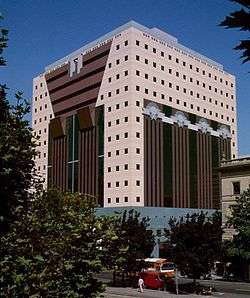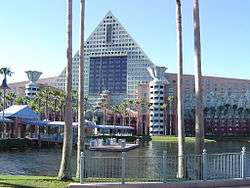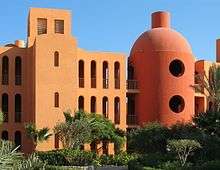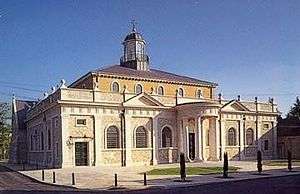Michael Graves
| Michael Graves | |
|---|---|
 | |
| Born |
July 9, 1934[1] Indianapolis, Indiana, US[1] |
| Died |
March 12, 2015 (aged 80)[1] Princeton, New Jersey, US[1] |
| Nationality | American |
| Occupation | Architect |
| Awards |
AIA Gold Medal[2] Driehaus Architecture Prize |
| Buildings | Portland Building, Denver Public Library, Walt Disney World Swan and Dolphin Resorts |
Michael Graves (July 9, 1934 – March 12, 2015) was an American architect. Identified as one of The New York Five, as well as Memphis Group, Graves was known first for his contemporary building designs and some prominent public commissions that became iconic examples of Postmodern architecture, such as the Portland Building and Denver Public Library. His recognition grew through designing domestic products sold by premium Italian housewares maker Alessi, and later low-cost new designs at stores such as Target and J. C. Penney in the United States.[1] He was a representative of New Urbanism and New Classical Architecture and formerly designed postmodern buildings, and was recognized as a major influence in all three movements.[3]
Personal life
Graves was born in Indianapolis, Indiana.[1] He attended Broad Ripple High School, receiving his diploma in 1952. He earned a bachelor's degree from the University of Cincinnati where he also became a member of the Sigma Chi fraternity. He earned a master's degree in architecture from Harvard University in 1959.[4] Graves won the Rome Prize in 1960 and spent the next two years at the American Academy in Rome.[5]
From 2003, Graves was paralyzed from the waist down as a result of a spinal cord infection.[6] He died at his home in Princeton, New Jersey on March 12, 2015 at the age of 80.[7]
Career
Architecture

From 1964 until the end of his life, Graves was an architect in public practice in Princeton, New Jersey.[1] He directed the firm Michael Graves & Associates, which has offices in Princeton and in New York City.
Early in his career, Graves was, along with Peter Eisenman, Charles Gwathmey, John Hejduk and Richard Meier, considered as one of the "New York Five",[8] a group of New York City architects who espoused a pure form of modernism. In contrast to his later career, Graves spent much of the 1970s designing modernist residences, such as the Snyderman House in Fort Wayne, Indiana.
For most of his career, however, Graves shifted away from modernism toward postmodernism and new urbanism. One of his most famous works, the Portland Building, which opened in 1982 in Portland, Oregon, is regarded as the first major built example of postmodern architecture.[3] The celebrated but controversial building, composed of municipal offices, is subject to an ongoing preservation debate.[3] It was added to the National Register of Historic Places in 2011.[9]
Graves subsequently received a number of major commissions. Some of his most notable completed buildings include the Humana Building[1] (a skyscraper in Louisville, Kentucky),[1] the Denver Public Library, and the renovation of the Detroit Institute of Arts. He built many buildings for the Walt Disney Company, including the company headquarters in Burbank, California,[3] Disney's Hotel New York at Disneyland Paris, and the Swan and Dolphin resorts at Walt Disney World. In the 1980s, he also designed an expansion for the Whitney Museum of American Art in New York City, but the highly contested design went unbuilt due to local opposition.[1]
Though Graves' prominence as an architect may have reached its highest point during the 1980s and into the early 1990s, he continued to practice as an architect throughout his life, completing various works such as the O'Reilly Theater, the NCAA Hall of Champions, 425 Fifth Avenue, and the Louwman Museum.
Graves also received recognition for his multi-year renovation of his personal residence in Princeton, nicknamed "The Warehouse".[10]
Product and furniture design
In 1985, Graves designed a stainless steel teakettle featuring a red whistle shaped like a bird[3] for the Italian company Alessi, which became the company's all-time bestselling product.[11]

Graves designed the scaffolding used for the restoration of the Washington Monument in Washington DC.[1] During that assignment, which Target Corp sponsored, he met a Target executive who appreciated his product design and a relationship was formed.[3] He began designing consumer products for the mass market and Target sold his products through their stores.[12] In 1998, Target commissioned Graves to design a model home to showcase the new line of housewares; Graves went a step further did a complete design of the contemporary house with custom furniture, lighting, fixtures, and other unique items, making it only one of three homes he designed and furnished. By 2009, however, he noted the house "doesn't have a wow factor. That gets old quickly."[13] The partnership went from less than a dozen objects in 1997 to more than 2,000 when the partnership with Target ended in 2012.[14] By 2013, concerned about Target's partnerships with other designers with less-successful outcomes, he explored other relationships to bring products to consumers. When the former Target executive became CEO of J.C. Penney, his products switched over to being sold exclusively through J.C. Penney.[14]
After Graves became paralyzed, his use of a wheelchair turned him into a "reluctant health expert",[3] with an increased awareness of accessible design. He focused his attention on the design of wheelchairs, hospital furnishings, hospitals, and disabled veteran's housing.[3]
Academia
In 1962, Graves became the Robert Schirmer Professor of Architecture, Emeritus at Princeton University. He held the position for thirty-nine years, while simultaneously practicing architecture, before finally retiring from the post in 2001.[1][5]
In 2014, the Michael Graves School of Architecture was established at Kean University in Union, New Jersey.[1]
Graves received honorary degrees from various universities, including Emory University,[15] the University of Virginia,[16] and the University of Miami.[17]
Awards and honors
Graves was elected a Fellow of the American Institute of Architects (AIA) in 1979. Graves was awarded the National Medal of Arts in 1999,[18] the American Prize for Architecture in 1994 AIA Gold Medal in 2001,[2]and the Driehaus Architecture Prize in 2012. He was also a Senior Fellow of the Design Futures Council.[19] In 2010, Graves was inducted into the New Jersey Hall of Fame.[20]
On November 22, 2014, the Architectural League of New York held a symposium in his honor, in which several prominent architects such as Steven Holl and Peter Eisenman as well as Graves himself served as guests and lecturers.[21] From October 13, 2014 until April 5, 2015, the Grounds for Sculpture in Hamilton, New Jersey held a retrospective exhibition of his work, entitled Michael Graves: Past as Prologue.[22]
Works






- Hanselmann House, Fort Wayne, Indiana, 1968
- Benacerraf House, Princeton, New Jersey, 1969
- Snyderman House, Fort Wayne, Indiana, 1972
- Wageman House, Princeton, New Jersey, 1974
- Fargo-Moorhead Cultural Center Bridge, Fargo, North Dakota, 1977
- Plocek Residence, Warren, New Jersey, 1977 (1st postmodern design)
- Roma Interrotta Exhibition, Rome, Italy, 1978
- Portland Building, Portland, Oregon, 1982
- Humana Building, Louisville, Kentucky, 1982
- Newark Museum expansion, Newark, New Jersey, 1982
- San Juan Capistrano Library, San Juan Capistrano, California, 1982
- Riverbend Music Center, Cincinnati, Ohio, 1984
- Aventine Mixed Use Development, La Jolla, California, 1985
- Crown American Building, Johnstown, Pennsylvania, 1986
- Team Disney Building, Burbank, California, 1986
- Graves Residence "The Warehouse," Princeton, New Jersey, 1986
- Shiseido Health Club, Tokyo, Japan, 1986
- Clos Pegase Winery, Calistoga, California, 1987
- University Of Virginia, Bryan Hall, Charlottesville, Virginia, 1987
- Dolphin Resort, Walt Disney World, Orlando, Florida, 1987
- Swan Resort, Walt Disney World, Orlando, Florida, 1987
- Metropolis Master Plan, Los Angeles, California, 1988
- Tajima Office Building, Tokyo, Japan, 1988
- Disney's Hotel New York, Euro Disney Resort (now Disneyland Paris), Marne-la-Vallée, France, 1989
- 10 Peachtree Place, Atlanta, Georgia, 1990
- Clark County Library and Theater, Las Vegas, Nevada, 1990
- Dairy Barn renovation, Harbourton, New Jersey, 1990
- Denver Public Library, Denver, Colorado, 1990
- Detroit Institute of Arts master plan, Detroit, Michigan, 1990
- Fukuoka Hyatt Hotel and Office Building, Fukuoka, Japan, 1990
- Kasumi Research and Training Center, Tsukaba, Japan, 1990
- Kavli Institute for Theoretical Physics, University of California, Santa Barbara, California, 1990
- Malibu House (private residence), Malibu, California, 1990
- Onjuku Town Hall, Onjuku, Japan, 1990
- University of Cincinnati College of Engineering, Engineering Center, Cincinnati, Ohio, 1990
- Youngstown Historical Center of Industry and Labor, Youngstown, Ohio, 1990
- Stockton University, Arts and Sciences Building, Pomona, New Jersey, 1991
- Thomson Consumer Electronics Americas headquarters, Indianapolis, Indiana, 1992
- United States Courthouse Renovation, Trenton, New Jersey, 1992
- Astrid Park Plaza Hotel and Business Center, Antwerp, Belgium, 1993
- International Finance Corporation Headquarters of the World Bank, Washington, DC, 1993
- Michael C. Carlos Museum, Emory University, Atlanta, Georgia, 1993
- Ministry Of Health, Welfare and Sport, The Hague, Holland, 1993
- Nexus Momochi Residential Tower, Fukuoka, Japan, 1993
- Archdiocesan Center, Newark, New Jersey, 1993
- Rome Reborn Exhibition, Washington, DC, 1993
- United States Post Office, Celebration, Florida, 1993
- 1500 Ocean Drive, Miami Beach, Florida, 1994
- Ocean Steps Retail Center with 1500 Ocean Drive, Miami Beach, Florida, 1994
- One Port Center (Delaware River Port Authority headquarters), Camden, New Jersey, 1994
- Pura-Williams House, Manchester-by-the-Sea, Massachusetts, 1994
- Miramar Resort Hotel, El Gouna, Egypt, 1995
- Topeka & Shawnee County Public Library, Topeka, Kansas, 1995
- The Engineering Research Center, University of Cincinnati, 1995
- American Academy in Rome Rare Books Library, Rome, Italy, 1996
- Charles E. Beatley, Jr. Central Library, Alexandria, Virginia, 1996
- House At Indian Hill, Cincinnati, Ohio, 1996
- Indianapolis Art Center, Indianapolis, Indiana, 1996
- Lake Hills Country Club, Seoul, Korea, 1996
- Miele Americas Headquarters, Princeton, New Jersey, 1996
- O'Reilly Theater, Pittsburgh, Pennsylvania, 1996
- French Institute⁄Alliance Française Library, New York, New York, 1997
- De Luwte House, Loenen aan de Vecht, Netherlands, 1997
- Drexel University North Hall Residence, Philadelphia, Pennsylvania, 1997
- El Gouna Golf Club, El Gouna, Egypt, 1997
- El Gouna Golf Hotel, El Gouna, Egypt, 1997
- El Gouna Golf Villas, El Gouna, Egypt, 1997
- Fortis/AG Headquarters, Brussels, Belgium, 1997
- Fukuoka Office Building, Fukuoka, Japan, 1997
- Hyatt Hotel Taba Heights, Taba Heights, Egypt, 1997
- Intercontinental Hotel, Taba Heights, Egypt, 1997
- Laurel Hall, New Jersey Institute of Technology, Newark, New Jersey, 1997
- NCAA Hall of Champions and headquarters, Indianapolis, Indiana, 1997
- United States Federal Courthouse, Washington, DC, 1997
- Bristol/Savoy Towers (Ten Good City), Fukuoka, Japan, 1998
- Cedar Gables House, Minneapolis, Minnesota, 1998
- Impala Building, New York, New York, 1998
- Castalia Building (Ministry of Public Health), The Hague, Netherlands, 1998
- Saint Martin’s College Library, Lacey, Washington, 1998
- New Jersey Institute of Technology Master Plan, Newark, New Jersey, 1999
- New Jersey Institute of Technology, Laurel Hall Expansion, Newark, New Jersey, 1999
- Philadelphia Eagles/Novacare Training Center, Philadelphia, Pennsylvania, 1999
- Pittsburgh Cultural District Service Center, Pittsburgh, Pennsylvania, 1999
- Private Residence, Harbourton, New Jersey, 1999
- Rice University, Martel, Brown & Jones Colleges, Houston,Texas, 1999
- Singapore National Library Competition, Singapore, 1999
- Target House Fountain, Memphis, Tennessee, 1999
- Washington Monument restoration and scaffolding Washington, DC, 1999
- Watch Technicum, Lancaster County, Pennsylvania, 1999
- 425 Fifth Avenue, New York, New York, 2000
- Capital Regional Medical Center, Tallahassee Community Hospital, Tallahassee, Florida, 2000
- Famille Tsukishima Apartment Building, Tokyo, Japan, 2000
- Federal Reserve Bank of Dallas Houston Branch, Texas, 2000
- Hart Production Studios, San Francisco, California, 2000
- Newark Museum Science Gallery, Newark, New Jersey, 2000
- Perseus Office, Washington, DC, 2000
- Private Residence, Lake Geneva, Switzerland, 2000
- United States Embassy Compound - Embassy & Housing, Seoul, Korea, 2000
- Children's Theatre Company, Minneapolis, Minnesota, 2001
- Fukuoka Office Building, Fukuoka, Japan, 2001
- Kasteel Holterveste, De Haverleij, Netherlands, 2001
- Mahler 4, Amsterdam, Netherlands, 2001
- Michael C. Carlos Museum Renovation, Emory University, Atlanta, Georgia, 2001
- Three On The Bund, Shanghai, China, 2001
- Arts Council of Princeton, Princeton, New Jersey, 2002
- Department of Transportation Headquarters, Washington, DC, 2002
- Kavli Institute for Theoretical Physics Kohn Hall, University of California, Santa Barbara, California, 2002
- National Museum of Prehistory, Taitung, Taiwan, 2002
- New Jersey City University Arts and Science Building, Jersey City, New Jersey, 2002
- New Jersey State Police Training Center & Headquarters, Trenton, New Jersey, 2002
- Resort Master Plan - Canary Islands, Canary Islands, Spain, 2002
- Rice University South Campus Master Plan, Houston, Texas, 2002
- St. Mary's Catholic Church, Rockledge, Florida, 2002.
- Target Club Wedd House contest prize, 2002
- Florida Institute of Technology Master Plan, Melbourne, Florida, 2003
- George Washington University Sigma Chi Fraternity House, Washington, DC, 2003
- Housing For Martin House, Trenton, New Jersey, 2003
- The Pinnacle And 260 Main Street, White Plains, New York, 2003
- United States Courthouse, Nashville, Tennessee, 2003
- Fox School of Business Alter Hall, Temple University, Philadelphia, Pennsylvania, 2004
- Indianapolis Art Center Master Plan, Indianapolis, Indiana, 2004
- Maxwell Place On The Hudson, Interiors Block A, Hoboken, New Jersey, 2004
- Princeton University Chancellor Green Interiors, Princeton, New Jersey, 2004
- Riverwalk 2, Nishinippon Institute of Technology Design School, Kitakyushu, Japan, 2004
- Trump International Hotel, Ft. Lauderdale, Florida, 2004
- University of Miami School Of Business, Miami, Florida, 2004
- 701 E. Baltimore, Baltimore, Maryland, 2005
- Azulera Resort, Hotel and Residences, Brasilito Bay Guanacaste, Costa Rica, 2005
- Burj Dubai Towers, Dubai, UAE, 2005
- The Enclave Residential Condominiums, Puerto Vallarta, Mexico, 2005
- Florida Institute of Technology College Of Psychology & Autism, Melbourne, Florida, 2005
- Hyatt Hotel, Beirut, Lebanon, 2005
- Luxury Condominium Towers, Beirut, Lebanon, 2005
- Maxwell Place On The Hudson, Interiors Block B, Hoboken, New Jersey, 2005
- Museum of the Shenandoah Valley, Winchester, Virginia, 2005
- Paterson Public Schools complex, Patterson, New Jersey, 2005
- Riverside Park Residential Development master plan, Fairfax County, Virginia, 2005
- Springhill Lake master plan, Greenbelt, Maryland, 2005
- Storehouse prototype retail store, West Palm Beach, Florida, 2005
- Allegria Residence, 6th of October City, Egypt, 2006
- The Falls at Lake Travis Community Master Plan, Austin, Texas, 2006
- Four Seasons Residence at Town Lake, Austin, Texas, 2006
- Minneapolis Institute of Arts Expansion, Minneapolis, Minnesota, 2006
- Notre Dame Club, Notre Dame University, South Bend, Indiana, 2006
- Private Residence, Sentosa, Singapore, 2006
- St. Regis Cairo, Cairo, Egypt, 2006
- Shake-a-Leg Residences, Miami, Florida, 2006
- St. Coletta of Greater Washington, Washington, DC, 2006
- Wyndham Hotels Prototypes, 2006
- Columbia University School of Nursing, New York, New York, 2007
- Community Master Plan, New Cairo, Egypt, 2007
- Detroit Institute of Arts, major renovation and expansion, Detroit, Michigan, 2007
- MarketFair Retail Center, Princeton, New Jersey, 2007
- Equestrian City Tower, Riyadh, Saudi Arabia, 2008
- Paul Robeson Center for the Arts, Arts Council of Princeton, 2008
- Mitchell Institute for Fundamental Physics & Astronomy and Department of Physics Building, Texas A&M University, College Station, Texas, 2009[23][24]
- Alter Hall, Fox School of Business, Temple University, 2009
- Princeton University Wu-Wilcox Halls Additions & Interiors, Princeton, New Jersey, 2006
- Resorts World at Sentosa, Singapore, 2010[25]
- Louwman Museum (National Automobile Museum), The Hague, The Netherlands, 2010
- PS/IS 42, Arverne, New York, 2012
See also
- Michael Graves: Images of a Grand Tour, Princeton Architectural Press, 2016. (ISBN 978-1616894733)
References
- 1 2 3 4 5 6 7 8 9 10 11 12 13 Pogrebin, Robin (March 13, 2015). "Michael Graves, Who Put Big Ideas Into Small Items" (obituary). The New York Times, Late Edition (East Coast). p. A1.
- 1 2 Groom, Robin (January 28, 2001). "Datebook". The Washington Post. p. F3.
- 1 2 3 4 5 6 7 8 Hawthorne, Christopher (March 12, 2015). "Michael Graves dies at 80; pioneering figure in postmodern architecture". Los Angeles Times. Retrieved 2015-03-13.
- ↑ "Michael Graves". Encyclopedia Britannica. Retrieved 12 March 2015.
- 1 2 Graves, Michael (2012-09-02), "Drawing with a Purpose", The New York Times
- ↑ Iovine, Julie V. (June 12, 2003). "An Architect's World Turned Upside Down". New York Times. Retrieved 2015-03-13.
- ↑ Pogrebin, Robin (March 12, 2015). "Michael Graves, Postmodernist Architect Who Designed Towers and Teakettles, Dies at 80". New York Times. Retrieved March 14, 2015.
- ↑ Goldberger, Paul (1996-02-11), "Architecture View: A Little Book That Led Five Men to Fame", The New York Times
- ↑ "Portland Building gets a place on national history list". Portland Tribune. November 17, 2011. Retrieved July 6, 2013.
- ↑ "Dwell Takes a Look Inside Michael Graves' Princeton Home". Curbed National. Retrieved 16 March 2015.
- ↑ "Alessi". Retrieved 28 May 2015.
- ↑ Pogrebin, Michael. "A pioneer of postmodern design, big and small". Toronto Star, 15 March 2015.
- ↑ Lynn Underwood, Gables by GRAVES, Star Tribune, September 12, 2009, accessed May 16, 2016.
- 1 2 "Designer Michael Graves on Moving to J.C. Penney". Retrieved 28 May 2015.
- ↑ "Honorary Degrees: Recent Recipients". emory.edu. Retrieved 16 March 2015.
- ↑ "Rita Dove to Deliver Emory Commencement Speech and Receive Two Honorary Degrees from Emerson College and Emory University". virginia.edu. Retrieved 16 March 2015.
- ↑ "History and Honorary Degree Recipients". miami.edu. Retrieved 16 March 2015.
- ↑ Snow, Shauna (September 22, 1999). "Morning Report". Los Angeles Times. p. 2.
- ↑ "Senior Fellows". di.net. Retrieved 16 March 2015.
- ↑ "City News: Greater New York Watch". Wall Street Journal, Eastern Edition. May 3, 2010. p. A27.
- ↑ Fred A. Bernstein. "The Mouse That Roared". construction.com. Retrieved 16 March 2015.
- ↑ "Exhibitions". Grounds For Sculpture. Retrieved 16 March 2015.
- ↑ "MItchell Institute Texas A&M University". Retrieved 20 February 2016.
- ↑ "Tour Mitchell Physics". Retrieved 20 February 2016.
- ↑ Zachariah, Natasha Ann. "American architect Michael Graves who masterplanned Resorts World Sentosa dies". Straits Times. Retrieved 5 December 2015.
External links
| Wikimedia Commons has media related to Michael Graves. |
- Official website
- The Michael Graves Contract Fabric Collection
- Michael Graves at the archINFORM database.
- 2012 video on YouTube feat. Graves, Driehaus Prize colloquium, Notre Dame School of Architecture
- "A Design for Living", Fast Company, August 2004
- Michael Graves interview, Architecture Daily
- Washington Monument scaffolding

